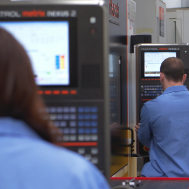Who works in CNC tool building?
Those who work in CNC tool building hold the title of CNC Machinist. CNC stands for Computer Numerical Control, and the operators of CNC equipment are called Machinists. A machinist operates, programs, and tests CNC tools like lathes, mills, and grinders in order to create precision rubber or plastic tools using metal.
Why CNC Machining?
According to Nathan Enser, a Apple Rubber Machine Shop Coordinator, the real benefit of CNC machining over traditional machining is the ability to make complex molds quickly and accurately.
Because a computer is responsible for moving tools around instead of a human operator, many minute adjustments can be made to those movements. This means that we can make molds with a lot of complex curves and cavities at Apple Rubber, and all of these cavities can be cut at the same time.
The CNC can work for hours or days without rest to accurately cut out these shapes. At the end of the process, we’re left with a mold with complex cavities that are very accurate and precise to one another.
Understanding the Process
Molds are first designed as a 3D model by a Project Engineer before coming to the Mold Shop. The CNC machinist takes these models and uses Computer Aid Manufacturing (CAM) to program the tool paths. These programs tell the CNC exactly what it needs to do in order to make that mold. This includes telling the CNC what tools to use, how fast to cut, and where to go.
First, the plate is molded and made to fit square and flat to the CNC Mill. We then perform roughing and finishing passes on our mold to get it to the correct final shape. This allows us to slowly get to the final size of a complex shape while making a mold.
During this process, our CNC Machinist is going to be checking the dimensions of the mold as the plates are cut to bring them to the correct size and verify that they match the 3D model that our Engineer created. After that, the molds get textured and/or sent out for plating before going through our assembly process. The assembly process is where the mold plates are put together and aligned and a hinge or handle are added if the mold needs it. Once that is done, the mold is ready to go out onto the production floor.
What do CNC Machinists do?
At Apple Rubber, a CNC Machinist takes raw steel plates and makes a mold that we can use to produce consistent, accurate rubber parts.
How to Get a Job as a CNC Machinist
Here, Nathan says it’s all about education. There are CNC machining certificate programs available all over the country, and CNC machinists are in demand.
To learn more about work in injection molding, contact us here.
Special thanks to Nathan Enser for sharing his expertise for this article.
